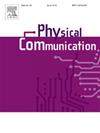Nonlinear energy harvesting based cognitive relaying with best relay selection
IF 2
4区 计算机科学
Q3 ENGINEERING, ELECTRICAL & ELECTRONIC
引用次数: 0
Abstract
This paper proposes a cognitive relaying scheme based on nonlinear energy harvesting, in which the licensed spectrum of the primary system is shared with the secondary system. The primary system comprises of an access point (AP) and multiple primary users (PUs). An energy-constrained secondary transmitter (ST), multiple secondary relays (SRs) and a secondary destination (SD) constitute the secondary system. ST uses the interference signal from AP to harvest energy. The transmit power of ST and relays should be strictly controlled to not exceed the interference constraint of all the PUs. The relay that has correctly decoded the ST’s data in the first-hop and brings the strongest signal power to the SD in the second-hop is selected to help ST transmit data to SD. Over the statistical properties of Rayleigh fading channels, we analyze the outage probability and throughput of the secondary system. We also present several benchmark systems for the performance comparison. Numerical results show that the protocol greatly improves spectrum efficiency and communication performance, and we emphasize the influence of various parameters on system performance.

求助全文
约1分钟内获得全文
求助全文
来源期刊

Physical Communication
ENGINEERING, ELECTRICAL & ELECTRONICTELECO-TELECOMMUNICATIONS
CiteScore
5.00
自引率
9.10%
发文量
212
审稿时长
55 days
期刊介绍:
PHYCOM: Physical Communication is an international and archival journal providing complete coverage of all topics of interest to those involved in all aspects of physical layer communications. Theoretical research contributions presenting new techniques, concepts or analyses, applied contributions reporting on experiences and experiments, and tutorials are published.
Topics of interest include but are not limited to:
Physical layer issues of Wireless Local Area Networks, WiMAX, Wireless Mesh Networks, Sensor and Ad Hoc Networks, PCS Systems; Radio access protocols and algorithms for the physical layer; Spread Spectrum Communications; Channel Modeling; Detection and Estimation; Modulation and Coding; Multiplexing and Carrier Techniques; Broadband Wireless Communications; Wireless Personal Communications; Multi-user Detection; Signal Separation and Interference rejection: Multimedia Communications over Wireless; DSP Applications to Wireless Systems; Experimental and Prototype Results; Multiple Access Techniques; Space-time Processing; Synchronization Techniques; Error Control Techniques; Cryptography; Software Radios; Tracking; Resource Allocation and Inference Management; Multi-rate and Multi-carrier Communications; Cross layer Design and Optimization; Propagation and Channel Characterization; OFDM Systems; MIMO Systems; Ultra-Wideband Communications; Cognitive Radio System Architectures; Platforms and Hardware Implementations for the Support of Cognitive, Radio Systems; Cognitive Radio Resource Management and Dynamic Spectrum Sharing.
 求助内容:
求助内容: 应助结果提醒方式:
应助结果提醒方式:


